Florida's Non-venomous Snakes
Eastern Garter snake, Eastern Ribbon snake, Southern Black Racer, Eastern Indigo snake, Florida Rough Green snake, Yellow Rat snake, Eastern Corn snake, Florida Banded Water snake, Southern Ringneck snake, Florida Kingsnake, Scarlet Kingsnake
Eastern Garter Snake - Thamnophis sirtalis sirtalis


A beneficial snake found throughout most of Florida, the Eastern Garter snakes range extends from Texas to Canada, it is absent from several Florida Gulf coast counties & the Keys. Average adult size is from 20 to 30 inches, the record is just over four feet.
Garter snakes are famous for aggregating behavior where a mass of male and females gather together in the fall to hibernate for the winter and mating the following spring.
Garter snakes vary somewhat in their coloration, generally it is three light stripes on a dark background, the stripes may be yellowish, bluish or brown. Between the center stripe and the two side stripes are alternating black spots in a checkerboard pattern.
Habit and Habitat - The Eastern Garter snake can be found in backyards, bottom land forest, stream and pond banks and in open fields, they are most active during the day but do come out at night, especially after a heavy rain when the earthworms and amphibians that make up their diet are active.
Eastern Ribbon Snake - Thamnophis sauritus sauritus


The Eastern Ribbon snake is a very close relative to the Eastern Garter snake and is very similar in appearance. Ribbon snakes are a slimmer bodied snake, 18-26 inches long and has a definite white spot just at the front of its eye socket and has white "lips", whereas the Garter snake has no white eye spot and has black lips.
Ribbon snakes have three light colored to yellow lateral stripes, one on the back and one on each side set against a dark background. Between each side stripe and the light yellow belly there is a brown lateral stripe.
Habit and Habitat - The Eastern Ribbon snake is one of four sub-species of Ribbon snake in the United States, three are found in Florida. This semi-aquatic native snake can be found in and around lakes, bogs and marshes where it preys on small fish and amphibians.
Southern Black Racer - Coluber constrictor priapus
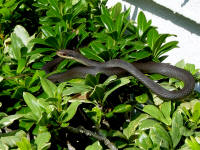
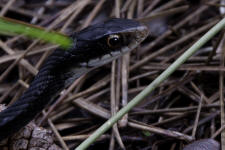
A very common snake is the Black Racer, it is found throughout Florida. These harmless snakes are frequent backyard visitors in most urban areas. A very nervous disposition means this snake will flee if approached by humans but will try to bite if cornered, the teeth are very small but can cut.
Adults range in size from 20 inches to just under 5 feet, the record is 72 inches. One of three sub-species of Black Racer this snake has a solid black back with smooth scales, white chin and reddish to orange-brown irises. Juvenile colors are grey with reddish brown splotches blending into a solid reddish tail.
Habit and Habitat - Found throughout Florida and the Florida Keys, this snake can be seen in Pine-land, Dry Prairie, Sandhill, Scrub and Cypress strands and domes, hardwood and sabal palm Hammocks. Black racers are good climbers and swimmers and move fast on land. Diet consists of frogs, lizards, small snakes, rodents, bird eggs.
Eastern Indigo Snake - Drymarchon couperi
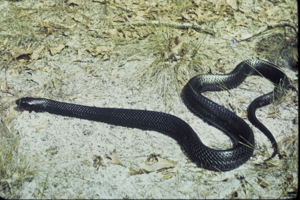
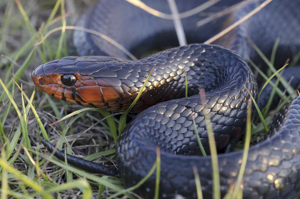
Found throughout Florida, Eastern Indigo Snakes were listed as threatened by the State of Florida in 1975 and in 1978 they were federally listed as threatened by the U.S. Fish and Wildlife Service.
This is the longest native snake species in North America, Eastern Indigo Snakes are not dangerous to people or pets. These snakes are not aggressive and avoid direct contact when possible.
These snakes occupy a wide range of habitats including scrub, tropical hardwood hammocks, pine flatwoods, prairies, coastal dunes, and the edges of freshwater marshes and cypress ponds. They also occupy various types of agricultural lands. They are commonly associated with Gopher Tortoise (Gopherus polyphemus) burrows, which they often use as refuges.
These snakes appear to prefer to eat other reptiles (including venomous snakes), but they are known to also eat amphibians, mammals, and birds.
Yellow Rat Snake - Pantherophis alleghaniensis
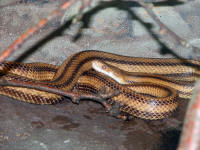
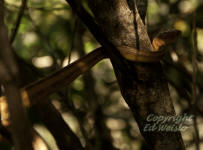
Adult Yellow Rat Snakes average between 36 and 72 inches long, the record is 90 inches. Juveniles are gray with a pattern of dark brownish blotches. Color is variable in adults from gray to yellow-orange, with four darker lateral stripes on the back and sides, adults may retain some of the darker blotches of the juvenile.
The Yellow Rat Snake can be found in a variety of habitats, including Pine lands, Mangrove and Cypress swamps, Prairies, Bottom land forests and Hammocks. This snake is mainly nocturnal and is a burrower as well as a good climber. Diet consists largely of rodents supplemented with small birds, bird eggs, lizards, frogs and toads.
Eastern Corn Snake, Red Rat Snake - Pantherophis guttatus

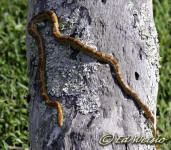

The Eastern corn snake is found throughout Florida, average adult is 20-40 inches long, record is 72 inches. Adults are a orange-brown color with blotches of brownish orange to red with black borders. Juveniles are similar in appearance to adults.
Also called the Red Rat Snake and like its cousin the Yellow Rat Snake it is both a burrower and a good climber.
Primarily nocturnal in habit, the Red Rat Snake feeds on rodents, amphibians, birds and eggs. This snake can be found in pinelands, hammocks, swamps, farm lands and urban areas.
Florida Banded Water Snake - Nerodia fasciata pictiventris
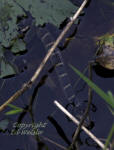
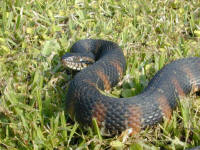
One of four species of water snake in Florida, this is a heavy bodied snake with an adult size of 24-42 inches.
Body has broad black, brown or reddish cross-bands separated by lighter bands of tan, Grey or reddish brown, there is a dark stripe extending from the eye to the corner of the jaw. Although this snake is not venomous it is capable of delivering a nasty bite, and it will bite aggressively when cornered, it also exudes a foul smelling musk when agitated.
The Florida Banded Water Snake is found throughout the peninsula except for the Keys. This common snake can be found in all fresh water bodies of water, swamps and marshes. Mainly a nocturnal snake, diet includes fish, frogs and other freshwater amphibians and crustaceans.
Florida Rough Green Snake - Opheodrys aestivus aestivus
_small.jpg)
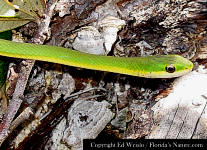
This is the only native slender bodied, bright green snake in Florida. Bright green on the dorsal side and creamy white to pale yellow underneath, belly color extends to the lower jaw and upper lip.
Adult length is 22-32 inches. this snake is arboreal and spends most of the time in shrubs and trees foraging for the insects that make up its diet, Florida Rough Green snakes tend to freeze when approached, making them difficult to distinguish among the vegetation.
Found in hardwood and bottomland forests, coastal scrub, maritime forest and hammocks on the east coast.
Southern ringneck snake - Diadophis punctatus punctatus

Also ring-neck snake or ringnecked snake.
Harmless to people or pets. Small slender snake, adults are 14-15 inches long maximum, coloration varies from a black to gray body, white to yellow ring just behind the head, a yellow-orange belly with reddish-orange color from the ventral region to the tip of the tail.
A very common species, they are nocturnal by nature and hide underground, leaf litter or other debris during the day so they are not often seen. Diet consists of small reptiles, amphibians, and insects.
Widespread throughout North America there are two sub-species recognized in Florida, Diadophis punctatus punctatus is found throughout Florida including the Upper and Middle Keys,and Diadophis punctatus acricus is found only on the Lower Florida Keys and is listed as a Threatened Species within Florida.
Florida Kingsnake - Lampropeltis floridana

Adults are 36 to 48 inches long, males slightly larger than females. The Florida Kingsnake has 34-78 narrow, light colored bands and a degenerate (broken or indistinct) chain pattern on its sides, the dark dorsal scales often fade in older snakes making the bands less prominate and giving the snake a speckled, yellow-ish appearence, there is no defined "neck" or narrowing behind the head. The belly has a checkered pattern with dark and light scales.
This snake is known to inter-breed with the Eastern Kingsnake (Lampropeltis getula) in the northern parts of its range resulting in offspring with a resemblance to either parent or a combination of the two.
Range of this snake includes all of the Florida peninsula south of a line from Duval county to Taylor county, the Florida Kingsnake inhabits pinelands, prairies, marshes, cypress strands and hardwood hammocks of S.Florida, as well as agricultural canals especially near sugar cane fields.
Preferred diet is other reptiles and their eggs, also birds, bird eggs, small mammals, lizards and other snakes including its own kind and being immune from their venom, venomous species of snakes as well.
Scarlet Kingsnake - Lampropeltis elapsoides
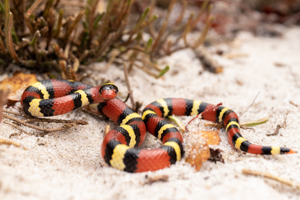
This snake mimics the Eastern Coral Snake with its similar markings and colors, the Scarlet Kingsnake is non-venomous and is harmless to people or pets. The difference is that the Eastern Coral snake has red and yellow bands that touch and a black snout. The Scarlet Kingsnake has red and yellow bands that are separated by a black band and a red snout.
Adults are 14-20 inches long with a slender body, females lay 2-8 eggs, usually uderground, under the bark of rotting logs or debris.
This snake is found throughout Florida and the eastern and southeastern U.S., although it typically inhabits wet pinelands, prairies, and mesic hammocks it can also be found in more upland habitat. Nocturnal, a shy burrowing species found under the loose bark of pine trees, fallen logs, rocks, and debris piles they are not often seen. Diet consists mostly of skinks and other lizards, small snakes, and the ocassional amphibian or small mammal such as mice.